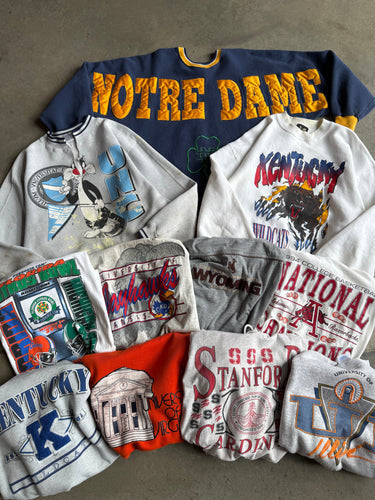How to Identify Vintage T-Shirts: A Comprehensive Guide

How to Identify Vintage T-Shirts: A Comprehensive Guide
Vintage t-shirts are not only nostalgic pieces of clothing—they’re collectible treasures that tell stories of past eras, music icons, and cultural movements. Whether you're a die-hard vintage enthusiast or just starting to explore the world of second-hand fashion, identifying an authentic vintage t-shirt can be tricky. With so many reproductions and remakes out there, how do you know if that graphic tee you found at the thrift store is truly vintage?
In this blog post, we’ll guide you through the essential steps to help you identify whether your t-shirt is a real vintage gem or just a modern replica. Let’s dive into the key factors that will help you recognize a vintage tee!
1. Examine the Tag and Label
The label on a vintage t-shirt is one of the best indicators of its age. Older tags were often unique and can give you clues about the shirt’s era. Here’s what to look for:
Branding: Vintage t-shirts often feature classic brand names that have either changed over time or no longer exist. Look for brands like Hanes, Fruit of the Loom, Gildan, and Screen Stars. The way these brands were labeled has evolved, so finding a vintage tag with older typography or materials is a good sign the shirt is from a past era.
Material Tags: Earlier t-shirts were made from cotton or a cotton-blend fabric, and the labels often listed the fabric content directly. In the 1990s and early 2000s, t-shirts began to feature more polyester blends. Tags made of thick, woven fabric, or those with faded or vintage fonts, are often indicators of age.
Made in the USA/Other Countries: Vintage t-shirts made in the USA were much more common prior to the 1990s, as many manufacturers moved overseas for cheaper labor costs. A “Made in USA” label can help date the shirt to the 1980s or earlier.
Size and Care Tags: Vintage t-shirts often feature handwritten or earlier versions of size tags (like small, medium, large in all uppercase letters). Care instructions were also less standardized in earlier decades, so if the care label is missing or uses older verbiage, it could be a sign of age.

2. Inspect the Fabric
Fabric quality plays a significant role in identifying vintage t-shirts. The material used in vintage tees differs greatly from the cheap synthetics common in modern shirts.
Cotton vs. Blends: Many vintage t-shirts are made from 100% cotton, which feels different than the cotton-polyester blends that are often found in modern tees. Vintage cotton t-shirts are usually thicker, with a sturdier feel that softens over time but remains durable.
Fabric Weight and Texture: Vintage tees often have a denser, more substantial feel. Modern t-shirts are typically made with lighter, thinner fabrics. If the shirt feels weighty or the fabric is rougher to the touch, it could be a vintage find.
Single Stitching vs. Double Stitching: One of the biggest giveaways for dating a vintage t-shirt is how it’s stitched. Vintage shirts, especially those from the 1990s and earlier, often feature single-needle stitching along the hems and sleeves. By contrast, modern t-shirts typically have double-stitched seams. A single-stitched hem can be a major clue that the shirt is from the ‘90s or earlier.
3. Examine the Fit and Cut
The fit of a vintage t-shirt can also tell you a lot about its age, as sizing and cuts have changed over the years.
Boxy or Relaxed Fit: Older t-shirts often have a more relaxed, boxy fit, whereas modern tees tend to have slimmer, more fitted silhouettes. If the shirt has wide sleeves, a slightly oversized body, or a straight cut, it could be a vintage piece.
Shorter Length: Many vintage t-shirts from the ‘80s and ‘90s tend to be shorter in length than modern t-shirts. If the shirt is cropped in a natural way or ends just above the waistband of your jeans, it’s likely a vintage style.
Neckline Shape: The shape of the neckline can also provide clues. Vintage t-shirts often have wider, more open necklines, especially those from the ‘80s and ‘90s. In contrast, modern t-shirts usually have a tighter, more structured crewneck.
4. Look for Distinctive Graphics and Printing Methods
Graphic prints on vintage t-shirts can give you a lot of information about when a shirt was made. The design, placement, and printing technique used in the graphic often change over time.
Older Printing Techniques: Vintage t-shirts were often printed using screen printing, a process that leaves the ink on the fabric’s surface, giving it a more textured feel. You may notice that vintage graphics often have a slightly cracked or faded look due to the ink aging. This is a sign of authentic vintage prints.
Direct-to-Garment Printing (DTG): Modern t-shirts often use more advanced printing methods like DTG, which results in softer, more vibrant prints. If a t-shirt has a vibrant, flawless design with no texture or cracking, it’s probably not vintage.
Graphic Design Style: The design itself can also offer clues about when the shirt was made. Graphic t-shirts from the 1960s and 1970s often feature bold typography, psychedelic patterns, or retro logos. The 1980s saw an explosion of pop culture references, from sports teams to concert tours, while the 1990s favored grunge, band logos, and animated characters.

5. Check the Overall Condition
While condition is not always a dealbreaker when identifying vintage t-shirts, the state of the fabric can tell you a lot about its age.
Fading and Wear: Vintage t-shirts tend to show signs of age, such as fading, small holes, or slight pilling. This doesn’t automatically mean the shirt is in poor condition. In fact, many collectors appreciate the "lived-in" look of a well-worn vintage tee, as it adds character and authenticity.
Yellowing: Many vintage tees, especially those made from 100% cotton, may have slight yellowing or discoloration around the neck and armpits. This is a natural result of the fabric aging and can be a sign that the shirt is genuinely old.
Deformation: Vintage shirts may have slight deformations in the collar or body from years of wear and washing. Modern t-shirts often hold their shape much better than older pieces.
6. Research the Brand and Era
If you still aren’t sure whether your t-shirt is vintage, a little research can go a long way.
Check for Date Stamps or Tour Dates: If your shirt has a graphic related to a band, concert, or event, check for dates, years, or specific tour names. These can help you narrow down when the shirt was made.
Consult Vintage Resources: There are numerous websites, forums, and Instagram pages dedicated to vintage clothing where you can research specific brands, t-shirt styles, and even identify rare pieces.
Conclusion
Identifying a vintage t-shirt is a thrilling experience, especially when you uncover a rare find. From examining the fabric and tag to checking for unique graphics, each step in the process helps you unravel the history behind the shirt. Whether you’re searching for a classic band tee or a retro logo from an old brand, paying attention to these details will ensure you’re bringing home a true piece of fashion history.
Happy hunting, and remember—vintage t-shirts are more than just clothing; they’re wearable pieces of nostalgia!
Damien

1 comment
i have a tee shirt from around 1980 and would like to get another one. the shirt has a watermark on it or some identifying mark. how can i get permission to use this tee shirt design or find another one like it?